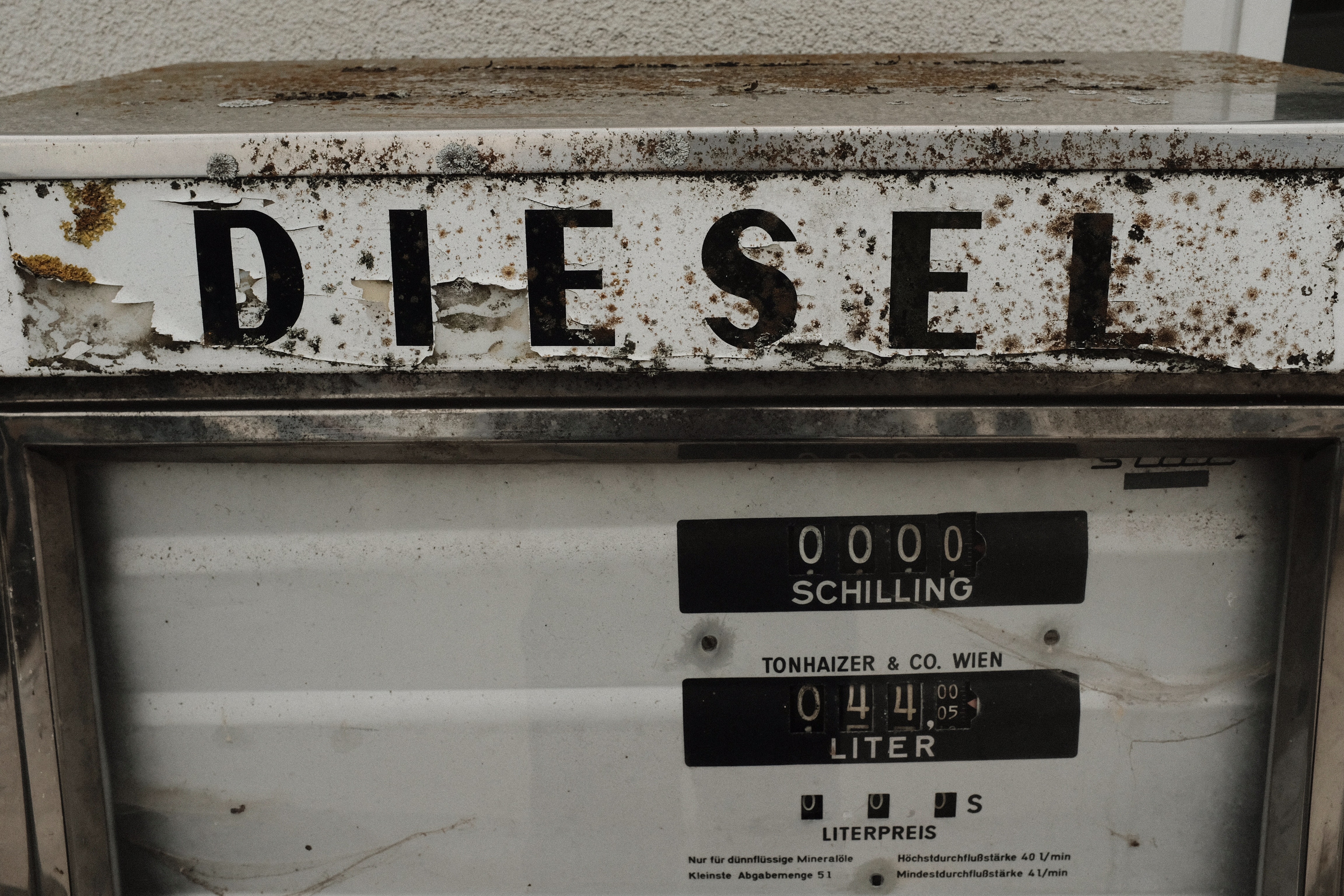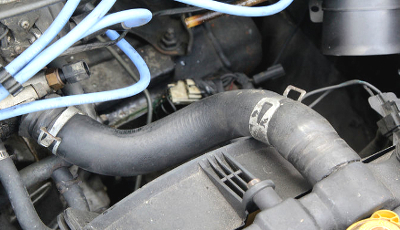
Winter Automotive Cooling System
Winter Automotive Cooling System
So, we understand you live in southern California with winter temperatures rarely dropping below 45 degrees in most areas, so why is it important to keep your cooling system maintained in the winter?
Our section on cooling system summer maintenance discussed how to keep your AC system running cool. Fall is the time to recheck your system because there may be times when you want to to visit snowy areas for skiing, and other winter activities and your car has to be ready.
Important Consumer Tips
In summer temperatures of over 90 degrees the temperature under your hood can reach 200-250 degrees, but those temperature ranges don’t change much more drastically than that even in winter periods of much lower temperatures. Remember, most of the modern cars are designed to run at higher temperatures and thermostats of 225 degrees are standard.

Here’s a scientific fact no mechanic can dispute, and it is not only an important maintenance consideration in keeping your car running smooth and lasting longer, but it is also a good illustration to show the importance:
Heat + Friction = Wear
The hotter you subject your car’s moving and connecting parts to become, the more wear you can expect from them. While you may feel that applies mainly to your engine and transmission, it also applies to your radiator, hoses, connectors which most modern cars use a lot of plastic, wiring, and rubber in their components. Plastic and wires suffer under constant overheating exposure. Even though hoses and wires are generally not moving, they have fluids and electrical current that moves through them. Your radiator and thermostat are designed to keep your auto running at a constant temperature and prolong the life of those parts.
One of the other very important factors is that most newer autos use a lot of aluminum and aluminum does not last long once overheated too many times and that can include the engine heads, a very costly repair should that happen.
Now that we have explained that formula to you, you can see the value in ensuring that your auto’s cooling system is maintained all year long.
Visual Consumer Tips
Here are Some Visual Consumer Tips You Can Check Yourself Periodically:
*Safety Note:
When opening the hood of your auto, even doing simple oil and transmission dip stick checks, avoid wearing long sleeve loose clothing as it could get caught in moving parts. We don’t suggest you check your fluids yourself for both safety and accuracy. So, the next time you’re in the area, just bring your car into all car and we’ll be happy to check them for you at no cost while you wait.
Engine Off
Always do a visual walk around before starting your car. Look under the front end, you’ll be able to see any radiator leak and oil leaks if there should be any from a few of the parts in the very front of the car.
Engine Running – Leak Check
Pull your car up just enough so you can see the area where it was parked or sitting for a while. If you see any leaks, draw a rough diagram of your car and put an X where the leak was. Check to see if it is red or darker. Red is usually a sign of a transmission fluid leak, all other is usually oil or radiator fluid.
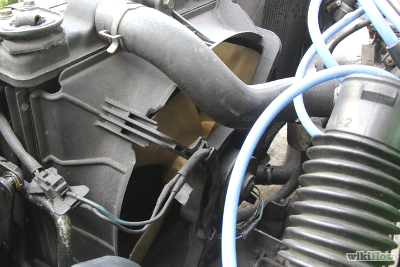
Engine Running – Under the Hood – VISUAL and AUDIO Observation ONLY
With your car in park and the parking brake on do a walk around a safe way to do this is to keep your hands down away from the interior of the engine compartment and walk so you avoid touching the car as you walk. This will position you close enough but ensure a safe distance to do a visual and audio observation.
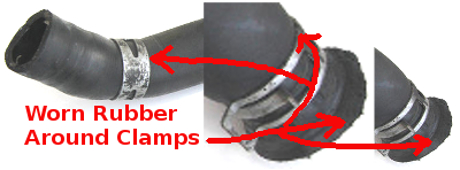
Above photo shows worn edges where it connects to the radiator. These worn edges around where they connect and where the clamps are can cause leaks.
Driving Check
Listen and feel for any unusual sounds or vibrations and if your auto has a temperature gauge be sure that it fluctuates between the correct temperatures. A car with a 225 degree thermostat will sometimes run, depending on stop and go situations, between 210 and 225 degrees. The thermostat is designed to stay shut initially until the engine reaches 225 degrees, then it opens to let the radiator fluid flow through the engine ports and radiator.
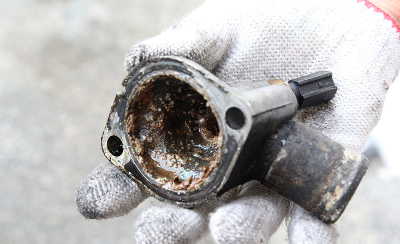
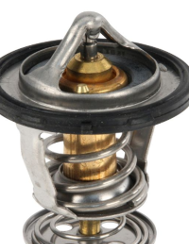
Above Photo Left: Old thermostat; Above Right: New thermostat showing the Springs
*Thermostat Option Possibility – If your car is overheating your car’s thermostat could need replacing as over time corrosion can cause them to stick. Or even if your car is constantly running at 225 degrees and you’d feel more comfortable with a lower thermostat, such as 195, 185, etc., stop by and see Paul and ask him if your car would be able to support a lower thermostat. Thermostats are not that expensive and some people do change them out to a lower one so your car runs at a cooler operating temperature, but it all depends on your specific make and model.
Proper Anti-Freeze – Fluids
To understand this topic, you must first realize that today’s automobile radiators are made of different metals such as aluminum and plastic that require very specific fluid types. While this may sound boring and a typical Ad for our services or a parts store, it is not. The reason, today’s vehicles have a lot of different metals that require a certain mixture of fluid for their function. Put the wrong anti-freeze in a new car and it can cause a lot of unwelcome and expensive repair problems, Domestic cars even many different makes as well as foreign all have their own specific requirements. So, the best way is to always check with your manufacturers statement, most vehicle guides will state their recommended fluid types; this also goes for oil, transmission and brake fluids as well.
Remember, your automobile’s automatic transmission has coolant lines running to it to keep your transmission fluid and transmission running cool, a very important part of your transmissions. Some transmissions are designed to just shut down if they heat up too much and you certainly don’t want that.
As we’ve stated before, your auto’s cooling system is probably the single most important part of your engine. When components heat up too much for too long they can fail or brake. It’s like exercising in the middle of Death Valley in the summer — if you don’t keep cool and with enough fluid, you’re in serious trouble!

